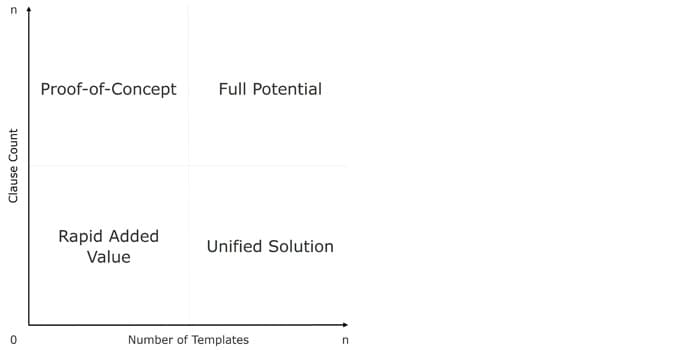Article

From template collection to the clause database
Exploit advantages and avoid typical mistakes – the Dos and Don'ts of clausification
Explore Content
- What is clausification?
- Advantages of clausification
- Scoping and planning of a clausification
- Content of the clausification process
- Lessons learned
What is clausification?
Clausification, also referred to as content deconstruction, is the process of breaking static contract templates into individual clauses and creating a library of clauses and dynamic templates. These templates reference the clause from the clause library using internal logic.
Advantages of clausification
Moving from a rigid contract template to a dynamic template and clause library offers many advantages. Amongst others, a dynamic template and clause library will:
- Reduce maintenance. If the wording of a clause is amended, any dynamic template that refers to the clause may benefit from it. Having to transfer new formulations into countless Microsoft Word templates, which is a time-consuming and error-prone process, thus becomes a problem taken off your plate.
- Accelerate design creation and negotiation. By utilizing logics, you can effortlessly create individualized contract drafts using your own preferred wording. Various technical platforms also allow defining so-called "fallback" clauses, which would enable you to adapt to typical change requests from another party, using an adjusted draft. Ideally, fallback clauses are already pre-approved by your legal department so that you can react to your business partners’ requests without having to “go through legal”.
- Strengthen compliance. While individual templates are often managed and maintained in a decentralized manner with varying levels of quality, the introduction of dynamic templates through granular version control and release management enables you to exercise a greater degree of influence over the content of the templates, and gives your organization more control over creating and updating them.
- Ensure the consistency of both content and form. The modular structure of dynamic templates ensures that your designs are not only consistent in terms of their content, but also regarding their structure and presentation. In addition, unification and standardization not only underline the professional appearance of your company, but also make it easier to work with your contracts throughout their life cycle.
- Enhance granular data. Through clausification, or content deconstruction, your company can capture numerous data points per clause, making them accessible for later reporting and analysis. With this concept, for example, evaluating which clause is included in which version of a particular draft contract becomes a much easier task for you to complete. Particularly in the context of risk assessments, it can be reliably ensured that no risks are hidden in unknown contractual passages.
Scoping and planning of a clausification
As part of the planning of a clausification project, it is important that you reflect on various essential preliminary aspects. We have found the following three-stage procedure to be helpful:
First stage: Identify in-scope templates
First, it is essential that you carry out an evaluation to determine which templates should be “clausified” at all. In practice, the following criteria have proven useful:
- Frequency of use. The more a template is used, the more noticeable the gain in quality and greater consistency from "reused" clauses becomes.
- Unification potential. The more clauses or contracts resemble each other, the easier the next steps of the clausification process become.
- Importance. The greater the economic or strategic importance of a template for the company, the greater the added value of clausification.
Second stage: Determine the desired depth of unification
Next, it is useful to determine to what extent clauses from your various templates should be consolidated to become “shared” clauses. This ranges from limiting the analysis to boilerplate clauses (such as severability clauses, choice of law clauses, assignment prohibitions) to reviewing all clauses of all templates for their unification potential.
Third stage: A cost-benefit calculation
The results of the first and second stages of the planning of a clausification project must then be placed in relation to each other. Here, too, an established procedure has emerged from practice:

- Rapid Added Value: For a small number of particularly suitable templates, selected clauses (typically the boilerplate clauses) are standardized. With this method, you can start adding value to your organization with manageable effort, and your project team can familiarize itself with the processes of clausification.
- Unified Solution: The standardization of boilerplate clauses across all templates is somewhat more demanding. The unified solution can serve as an intermediate step towards complete clausification or represent the permanent target state of your project.
- Proof-of-Concept: For a small number of particularly suitable templates, the maximum standardization of all clauses may be attempted. This approach is used to test whether a “complete unification” can also be useful for other templates.
- Full Potential: All clauses and templates are standardized as far as possible, and once they are integrated into the process, the full potential of clausification is realized.
What the best approach for one of your particular projects is, depends on many factors. How much time do you have? Who in your team can support the clausficiation – and are they the right person(s) for the job? What budget has been allocated for your project? Do you have support from within your company?
Particularly for companies that are tackling this topic for the first time, it is advised that you approach the clausification project step-by-step, whereby, after initial experience, you can proceed with increasingly demanding clausifications.
Content of the clausification process
Once you have completed the planning phase of the project, concrete clausification can begin. The following steps are suitable for this purpose:
- Template cleanup. Selected templates generally still need to be prepared for the upcoming clausification. If multiple templates exist for the same type of contract, you should first determine which template is the most appropriate one (or create a consolidated one from the different templates). Using the same heading or outline levels and numbering in all templates and aligning them in terms of formatting in all other respects as well can aid you in this process. Furthermore, it can be helpful to split extensive clauses with multiple regulatory contents into smaller components for subsequent standardization.
- Identify the “gold standard” per clause. For each clause that is to be used in more than one template, your company’s internal “gold standard” must be determined, i.e., the wording that best covers the company’s interests. In addition, you can alternatively also prepare “fallback” clauses (e.g. as a negotiation option) as well.
- Assess differences. The final step is to compare your “gold standard” clauses to clauses with the same content across templates. You must decide whether standardization (i.e., adopting the “gold standard” wording) is an option or should be ruled out for whichever compelling reasons. You should repeat this process until all your clauses in the templates that are intended to be unified have been reviewed.
Lessons learned
Resource-based scoping. If your project team has little experience with clausification, it is important not to take on too much at once. Instead, focus on small designs, such as “Rapid Added Value” (see above) as a “Phase 1” of your project. This provides your team with a swift sense of achievement, which forms the foundation for success in subsequent project phases.
Select and understand the technical platform in good time. From a purely practical point of view, clausification is only possible if you use suitable technical platforms that also set the technical framework for clausification through its specific functionality. If your platform does not offer certain functionalities, you may find yourself unable to implement the clausification in the way your project team may have envisioned. For example, if you frequently work with references to other paragraphs of the contract in your templates (“Unless otherwise provided in Section 3 para. 2...”), you should ensure that this reference technique can be technically mapped in the (shared) clauses and dynamic templates – or be aware of the appropriate time and effort needed to adjust the contract wording and structure due to the technical limitations of the platform.
Recognize the clausification project as a transformation project, not (only) as a technology project. Even though the clausification project typically involves the introduction of a new tool (or at least the new use of an existing tool), try not to see it purely as a technology project. Make sure that in addition to the strong legal component other aspects of change-management are not neglected. In particular, transparent stakeholder communication as well as sufficient and comprehensive training offers should be part of any of your clausification projects.
Published: July 2022
Recommendations
The Deloitte Approach – Legal Management Consulting
A changing world requires a new approach to law
How to choose the right Contract Lifecycle Management platform?
A recent whitepaper from the Liquid Legal Institute provides answers



